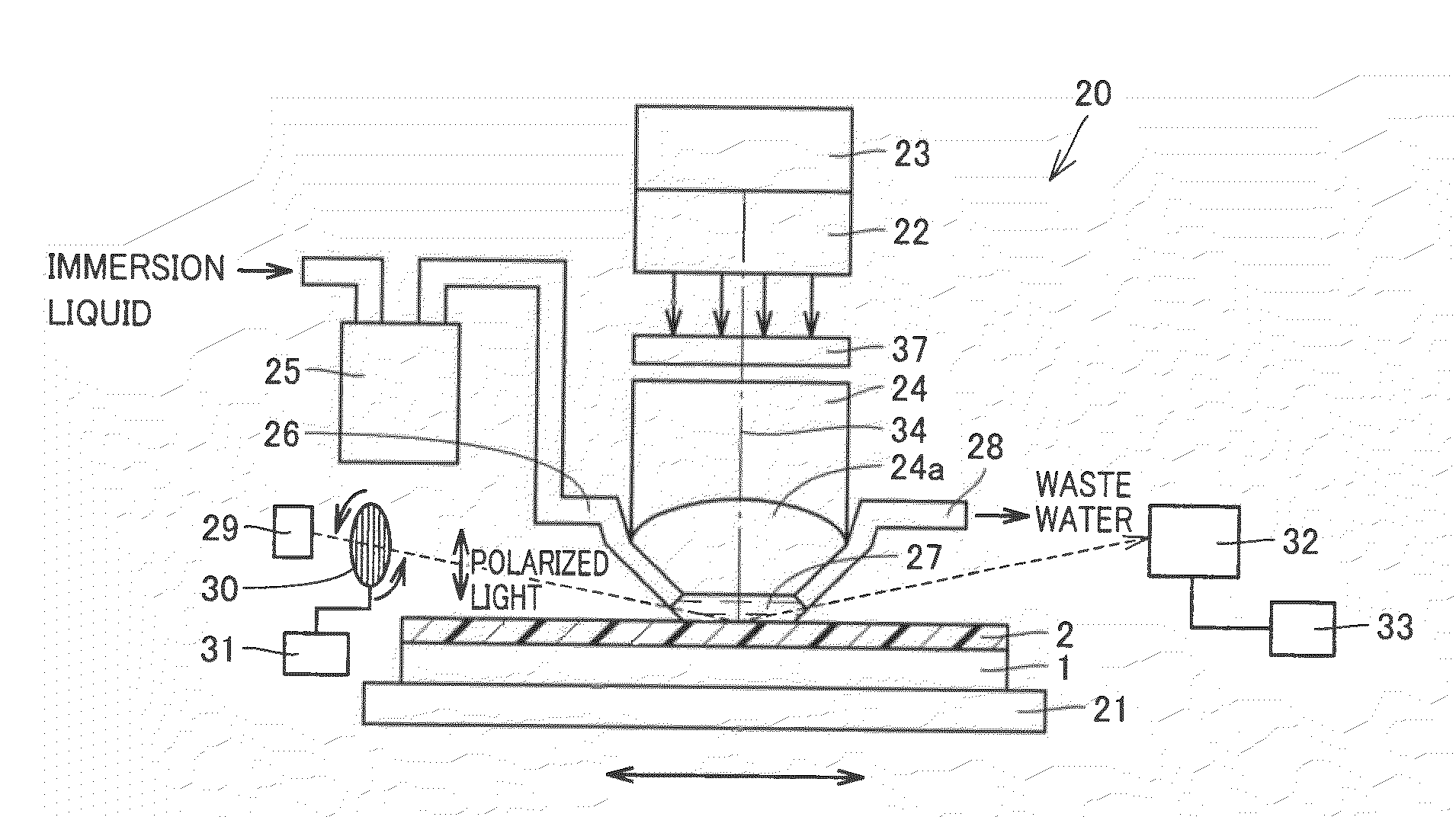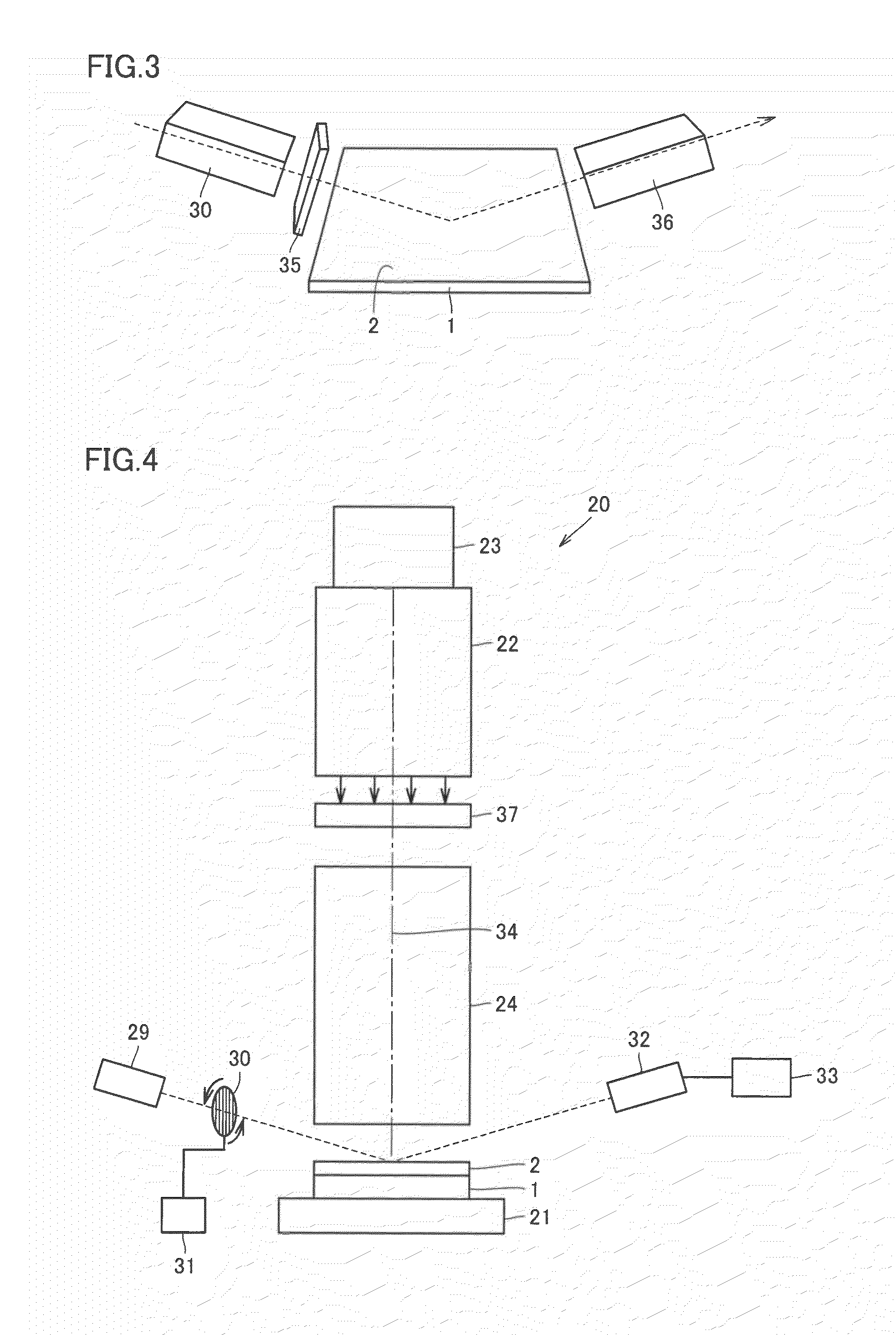Method of fabricating semiconductor device
a semiconductor and device technology, applied in semiconductor/solid-state device testing/measurement, instruments, photomechanical equipment, etc., can solve problems such as difficult detection of focal points at the time of exposure in real time in a similar method, detection errors may occur, and problems tend to become conspicuous, and achieve high-quality patterns.
- Summary
- Abstract
- Description
- Claims
- Application Information
AI Technical Summary
Benefits of technology
Problems solved by technology
Method used
Image
Examples
first embodiment
[0049]FIG. 1A is a diagram showing a general configuration of a liquid immersion lithography unit 20 according to the first embodiment of the invention. Liquid immersion lithography unit 20 according to the first embodiment may be an exposure apparatus of step-and-scan type, step-and-repeat type or other types.
[0050]The use of liquid immersion lithography unit 20 as in the first embodiment can meet the requirements for fabrication of a semiconductor device with the design rule of, for example, not more than 45 nm, and makes it possible to form a resist pattern of about not more than 130 nm. In the first embodiment, an application of the invention to a liquid immersion lithography unit. Nevertheless, the present invention is applicable also to an exposure apparatus other than the liquid immersion lithography unit.
[0051]As shown in FIG. 1A, liquid immersion lithography unit 20 according to the first embodiment includes an illumination optical system 22 having an exposure light source ...
second embodiment
[0114]Next, a second embodiment of the invention is explained with reference to FIGS. 19 to 24.
[0115]In the first embodiment described above, an anti-reflection film such as BARC having the ability to absorb the focal point detection light (450 nm to 850 nm) is used for the layer lower than the resist film. In the second embodiment, on the other hand, an upper layer film (top coating material) higher in refractive index than the resist film is formed on the resist film. This upper layer film, being alkali soluble and capable of absorbing the focal point detection light (450 nm to 850 nm), can be formed of a film high in refractive index. The other components are basically similar to the corresponding ones of the first embodiment.
[0116]FIG. 19 shows an example of the film structure on substrate 1 according to the second embodiment. As shown in FIG. 19, the film structure according to the second embodiment includes silicon oxide film 3 of 200 nm formed on the main surface of substrate...
third embodiment
[0133]Next, a third embodiment of the invention is explained. According to the third embodiment, the configuration of the focal point detection unit for detecting the focal point at the time of exposure is different from that of exposure apparatus 20 according to the first embodiment. The other component parts are basically similar to those of the first embodiment.
[0134]As shown in FIG. 3, according to the third embodiment, a photoelastic modulator 35 is interposed between polarizer 30 and substrate 1, and an analyzer 36 is inserted between substrate 1 and light detector 30 (FIG. 1). Also, the third embodiment uses, as the detection light, a linearly polarized light at 45° with the angle of incidence and wavelength as variables. A similar polarizer to that of the first embodiment is usable as polarizer 30. Analyzer 36 includes optical elements such as a polarizing plate, lens, prism and multichannel CCD capable of handling the incidence angle and the wavelength as variables to detec...
PUM
 Login to View More
Login to View More Abstract
Description
Claims
Application Information
 Login to View More
Login to View More - R&D
- Intellectual Property
- Life Sciences
- Materials
- Tech Scout
- Unparalleled Data Quality
- Higher Quality Content
- 60% Fewer Hallucinations
Browse by: Latest US Patents, China's latest patents, Technical Efficacy Thesaurus, Application Domain, Technology Topic, Popular Technical Reports.
© 2025 PatSnap. All rights reserved.Legal|Privacy policy|Modern Slavery Act Transparency Statement|Sitemap|About US| Contact US: help@patsnap.com



